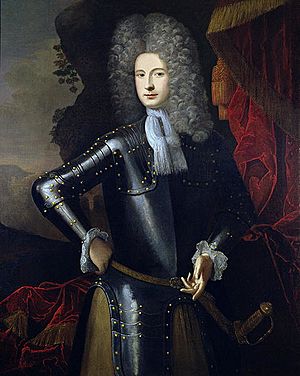Henry Dillon, 8th Viscount Dillon facts for kids
Quick facts for kids
Henry Dillon,
|
|
|---|---|
| Viscount Dillon | |
 |
|
| Tenure | 1737–1714 |
| Predecessor | Theobald Dillon, 7th Viscount |
| Successor | Richard Dillon, 9th Viscount |
| Died | 13 January 1714 Dublin |
| Spouse(s) | Frances Hamilton |
| Issue Detail |
Bridget & Richard |
| Father | Theobald Dillon, 7th Viscount |
| Mother | Mary Talbot |
Henry Dillon, 8th Viscount Dillon (died 1714) was an important Irish soldier and politician. He lived during a time of big changes in Ireland. In 1689, he was part of the Patriot Parliament. He also fought for the Jacobites during the Williamite War. He defended the city of Galway and later got his family's lands back.
Contents
Early Life and Family Background
Henry Dillon was born around 1665. He likely grew up at his family's home in Kilmore, County Roscommon, Ireland. He was the second son of Theobald Dillon and Mary Talbot. Henry was the oldest son who survived to adulthood.
His father's family, the Dillons, were part of the "Old English" families in Ireland. This means their ancestors came from England with Prince John way back in 1185. Henry's mother, Mary Talbot, also came from an "Old English" family. Her uncle was Richard Talbot, 1st Earl of Tyrconnell, a very powerful person in Ireland at the time. Both of Henry's parents were Catholic. Henry had a younger brother named Arthur, who later became a general in the French army.
Joining the Army
In 1683, Henry's father became the 7th Viscount Dillon. This meant he inherited the title and lands. A few years later, in 1688, a big event called the Glorious Revolution happened in England. This led to King James II losing his throne.
King James II was Catholic and had many supporters in Ireland, known as Jacobites. Henry's father raised two army groups (regiments) to support King James II. Henry was put in charge of one of these regiments, and his younger brother Arthur led the other.
Marriage and Children
In July 1687, Henry Dillon married Frances Hamilton. She was the daughter of Sir George Hamilton. Frances's step-father was Richard Talbot, 1st Earl of Tyrconnell, who was the Lord Deputy of Ireland. Frances and her two sisters were famous in Ireland. They were known as the "three viscountesses" because all three sisters married Irish viscounts.
Henry and Frances had at least two children:
- Bridget
- Richard (who died in 1737)
A Life of Service
In 1689, Henry Dillon became a member of parliament for County Westmeath in the Patriot Parliament. This was a parliament called by King James II in Ireland. In the same year, he also served as the Lord Lieutenant of County Roscommon. A Lord Lieutenant was a representative of the king in a county.
Henry's father, the 7th Viscount, died in the Battle of Aughrim on July 12, 1691. He was fighting for the Jacobites against the Williamites. The Williamites were supporters of King William III. After his father's death, Henry became the 8th Viscount. However, his father had been declared a traitor (this is called being attainted) by the Williamites. This meant that, in the eyes of the winning side, there was no title or land for Henry to inherit.
Henry was the governor of Galway for the Jacobites. After the Battle of Aughrim, the Williamite general, Ginkel, marched to Galway. Ginkel surrounded the town on July 18. Henry surrendered Galway on July 26, after making an agreement. He and his troops then marched to Limerick.
The Williamites then began a siege of Limerick in August 1690. During the fighting, Henry's mother, Mary, sadly died. The first siege ended, but a second siege happened in 1691. The Williamite War in Ireland finally ended with the Treaty of Limerick on October 8, 1691.
After the war, many Jacobite soldiers left Ireland. This event is known as the Flight of the Wild Geese. But Henry Dillon stayed in Ireland. He worked to get his father's attainder reversed. In 1694, a court agreed to reverse it. This decision was confirmed in 1697. This meant Henry got his title and lands back.
Death and Succession
Henry Dillon died on January 13, 1714, in Dublin. He was buried in Ballyhaunis in County Mayo. His son, Richard, became the 9th Viscount. Richard died in 1737 without any sons. So, the title then passed to Henry's nephew, Charles. Charles was the son of Henry's brother, Arthur.
Key Dates in Henry Dillon's Life
| Age | Date | Event |
|---|---|---|
| 0 | 1665 (approx.) | Born in County Roscommon. |
| 22 | 1687, July | Married Frances Hamilton. |
| 24 | 1689 | Sat in the Patriot Parliament. |
| 26 | 1691, July 12 | His father died in the Battle of Aughrim. Henry became the 8th Viscount. |
| 26 | 1691, July 26 | Surrendered Galway to General Ginkel. |
| 29 | 1694 | His father's attainder was reversed, and Henry got his title and lands back. |
| 49 | 1714, January 13 | Died in Dublin. |
Images for kids


